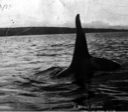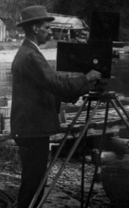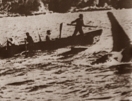

Killer Whale, Orcinus Orca, from the Latin Orcus : Demons from the Underworld,
belonging to the realms of the dead.
For thousands of years, killer whales have hunted the great baleen whales in
every ocean on earth, yet only in one place have they ever co-operated with
humans to hunt whales, and then largely only with one family, the Davidsons. “Killers of Eden” is the extraordinary story of the contract between man and one of nature’s most powerful and intelligent creatures.
Each year for more than a century on Australia’s far south east coast, autumn moved into winter and the killer whales would return to Eden from the
Antarctic and lie in wait. Their prey were the baleen whales journeying to and
from their breeding grounds hundreds of kilometers up the coast. Three
generations of the Davidson family worked with the killer whales, often invited
by the killers and led out to sea to join in the hunts. A few members of the
pod of orcas would swim right into the mouth of the kiah river where the
Davidsons had their two isolated houses on the opposite side of the bay from
the township of Eden. They would then breach or thrash their tails on the water
surface untill the whalers emerged and rowed their boats out to meet them. The
Davidsons called this behaviour “flop-tailing”. No other Eden whalers were ever visited in this manner. On cloudy moonless nights, the Davidson crews would follow the glowing
bioluminescent trails of the orcas which would light up the sea.
When the whale was dead, the Davidsons would simply row home after tying an
anchor and small buoy to it, leaving first spoils to the killers. Just like
orcas elsewhere in the world, the Eden killers only ate the tongue and lips and
discarded the rest.
After a few days the whale would float to the surface and the Eden whalers would
row out and tow the remains for “trying out” at their tiny whaling station on the banks of the Kiah river in Twofold bay.
The whalers called this arrangement “the law of the tongue” and as a result, far less of the whale was wasted than if the Orcas had hunted alone.
The relationship became so close that the whalers would attempt to rescue the
killers if they became entangled in ropes and the killers would protect the
humans from sharks if the flimsy green whaleboats were smashed. As a result,
few fatalities occured amongst the crews, despite regular serious accidents.
The killers could easily differentiate between the Davidson’s green row boats and competitors boats of other colours. Captive orcas in
aquariums have no trouble recognising individual humans, distinguishing between
others wearing identical clothing such as wetsuits. so the Eden killers could
likely have recognised individuals amongst the Davidson crews. The Davidson
boats’ green colour was based on the green of the traditional Scottish Davidson
tartan.
The Davidsons never used motor boats to catch whales. Only rowboats. Sometimes
motor launches were offered for use as pick-up boats in case of accidents or to
tow whales to shore. In the final decade of whaling in the 1920s the Davidsons’ neighbour J.R. Logan would occasionally give the row boats a tow out to a chase
with his yacht the “White Heather”, but no bomb-gun or harpoon was ever fired from a motor boat in twofold bay.
The Davidsons avoided using explosive “bomb-guns” to catch whales because the concussive noise greatly distressed the killers and
discouraged them from co-operating.
Using modern technology is not traditional, and is not “cultural whaling”.
Subsistence hunting
The Davidsons would rarely catch more than 8 whales a year in their subsistence
level operation and likely had minimal impact on whale numbers. They mostly
only caught what the killer whales were hunting naturally. The orcas did
regularly attack southern right whales which became very rare.
By comparison, Tangalooma whaling station in Queensland took over 700 whales
each year in the 1950s, devastating humback numbers at a much faster rate than
they could possibly reproduce.
Modern day Japanese and Nordic whalers, in defiance of scientific and world
opinion and ignoring a worldwide moratorium on commercial whaling, kill more
whales in a single year than most Eden whalers took in a whole lifetime.
If you are interested in direct intervention against the poaching of whales,
then you may wish to read about and support the Sea Shepherd Organisation.
The Killers Decline
In 1900 the killer pack numbered over 15 individuals untill a vagrant named
Harry Silks knifed the killer Typee to death on Aslings beach. Other sources
state the killer Jackson was killed. Immediately the killer pack left the bay
for the remainder of the season and the following season only six returned.
Whilst it has been suggested that the disappearance of the killers was a result
of dwindling food supply, large scale hunting of eastern coast humpback
populations did not actually occur untill the 1950s, a whole half century after
Typee’s killing and the Eden pack spliting in two. The population of humpbacks at the
time of Typee’s 1900 killing and splitting of the pod has been estimated by pacific whale
foundation scientists as being the same as its pre-european settlement
population.
The Davidsons became aware that during WW1 the killers were being deliberately
shot and killed by Norwegian whalers working from Queensland who were oblivious
to their non-competetive assistance to the Eden whalers. Archer Davidson
specifically mentions that as a reason for the killers numbers dwindling in
that time period.
Old Tom himself passed away in 1930, 30 years after Typee yet still 20 years
before large scale whaling for humpbacks in Australia.
The skeleton of “Old Tom”, the last of the Eden Killers is preserved to this day in the Eden Killer Whale
Museum and bears testament to the extraordinary tales told about him. Tom’s death in 1930 brought the 100 year period of whaling in Eden to a close.
100+ years of documentation
No mere myth or the recollections of foggy memories, whilst it was occuring, the
Eden story was documented in a hundred years worth of Australian newspapers,
police records, court transcripts, diaries, postcards, Australian Government
Hansard, journals, and books and for an additional 75 years of oral history
accounts and tape and video recordings. The events were viewed by hundreds of
eyewitnesses, members of government, leaders of industry, priests and
ministers, knights of the realm. It was most fortunately also documented in hundreds of photographs by two full
time photographers over a 40+ year period and was filmed by a 35 mm Prestwick
movie camera in one of the world’s first documentaries in 1910. It was first shown publicly in the “Lycic Picture Palace” in Redfern, Sydney in 1912.
Many of the photos were taken by C.E. Wellings or W.T. Hall and have been
collected by Rene Davidson, grandson of master whaler George Davidson. Many of
these photographs are represented by original glass negatives.
Copies of the 1910 movie film were destroyed by a fire, probably caused by the
nitrate film-stock itself, in the Bega bank in 1913 and only a few frames have
survived. If anyone has information on any other surviving copies or negatives
please contact the website author.
Inter-species Interaction
Some people find it difficult to believe that over a 100+ year period of
inter-species contact, encompassing many generations and with the mutual
rewards of greater efficiency and food , orcas and humans could develop a
co-operative relationship whilst hunting the same prey. Yet those same people
have no trouble accepting that with no prior contact with humans, wild orcas
placed in aquariums within months will interact with humans, eventually
allowing them to ride on their backs or perform huge leaps with humans standing
on their snouts. Orcas are intelligent and curious and will even intently study
books about whales as has been documented by Dr John Ford of Vancouver
aquarium. Doubters may care to view video footage of this behaviour.
Wild orcas will spontaneously begin to habituate to and generate relationships
with humans, as was actually problematic in the case of “Luna”, originally a member of L-pod who took up residence in Nootka sound in
Vancouver Island British Columbia. Members of the First Nations Mowachaht
people there believed that Luna was the Re-incarnation of one of their elders
and encouraged the interaction. This parallels the Yuin people’s beliefs in Eden.
Orcas are very social beings, and particularly in the absence of their own kind
may seek out social contact with other creatures such as humans. Tragically,
Luna’s fascination with people and boats led to a fatal accident between Luna and a
tugboat propellor.
Documentary and Film
The story of the Eden killers has recently been made into a spectacular, award
winning documentary “Killers in Eden” by the ABC natural history unit, produced by Klaus Toft.
The documentary is based on research from original source materials by Zoologist
Danielle Clode and oral history interviews, document and image research by
historian, VFX expert and film maker Greg McKee.
Greg and colleague Alister Ferguson also produced and supervised photorealistic
visual effects for the program. The documentary is available on DVD from a
number of sources.
An even more exciting and profound feature film movie version is presently in
development based on over 20 years of extensive new research from original
sources and interviews with Eden whalers, family and townsfolk.
If you think the choreography of the Orca action for “Happy Feet” was spectacular, wait till you see what is in store for the Eden Killers
feature film, which will imerse the audience into the world of the Killer
whales, as well as the whalers.
Killers return
After having virtually disappeared from Twofold Bay since 1930, pods of killer
whales have begun to return to the Bay and have even been observed visiting the
mouth of the Kiah river. Whale remains and recent eyewitness accounts
demonstrate that these present day orcas continue the whale hunting traditions
of the original Eden pack. It is interesting to speculate that these killers
may be descendants of the original Eden pods.
Eden today is a fantastic location for whale watching and supports a number of whale watching vessels. Humpback whales are regular
visitors to the bay and may be observed feeding and cavorting with spectacular
displays of acrobatics.
Vast numbers of people now experience these magnificent creatures at close range
in the beautiful surrounds of Twofold Bay. Local cameraman Peter Constable produces beautiful videos of these regular
marine visitors to Eden.
Outside whale migration season, the vessels conduct tours of the bay and visit
historic locations.
Explore this site and read further details of Killer Whales, the Davidsons, Old
Tom and Eden locations.
Read the stiring words of Effie Davidson, recorded on the eve of her 100th birthday in 1940: An Old Lady Remembers.
Watch and listen to recent video interviews with members of the Davidson family and other Eden locals who lived the story
themselves and visit the site for updates about exciting developments related
to the story .
Many pictures were kindly made available by Mary Mitchel, daughter of C.E.
Wellings.
All images and videos on this site are protected by international copyright law
and may not be reproduced for any commercial purposes or used on other websites
without permission of the authors.
Any assistance in tracking the fate or whereabouts of the historic vessel the “White Heather” would be greatly appreciated. Images of this historic vessel in and out of the
water are viewable in the link above.
R.I.P. Rene Davidson 1933-2008
It is with great sadness to note the passing of Rene Davidson on the 1st january
2008.
Rene was a tireless historian and enthusiast for all things related to the sea.
Rene was a great friend, co-conspirator and one of Eden’s finest sons. He will be greatly missed.
Many thanks are due to Rene Davidson for access to pictures and introductions to
the Davidson family and Eden locals.
Rip Doug Ireland 2010
Ecclesiastes chapter 3 verses 17-21..... “I said in mine heart concerning the estate of the sons of men, that God might
manifest them, and that they might see that they themselves are beasts, for
that which befalleth the sons of men befalleth beasts: even one thing befalleth
them. as one dieth, so dieth the other: yea, they have all one breath; so that
a man hath no preeminence above a beast; for all is vanity.
website researched and created by Greg McKee
greg@mckeewildthings.com

The Killer “Old Tom” most famous of the Eden Killers.

C.E.Wellings at the kiah tryworks with the 35mm Prestwick movie camera.

Tom and George in action in a still from the 1910 movie

Tom alongside a whale boat.

A typical shark that would follow the whale chases.
When the boats were smashed the killers would circle the men in the water,
abandoning the chase untill the crews were rescued.

Luna, the wild orca from British columbia in a spontaneous voluntary interaction

A human-orca interaction after only a few years of contact rather than
generations.
This Orca captured from a wild population.










